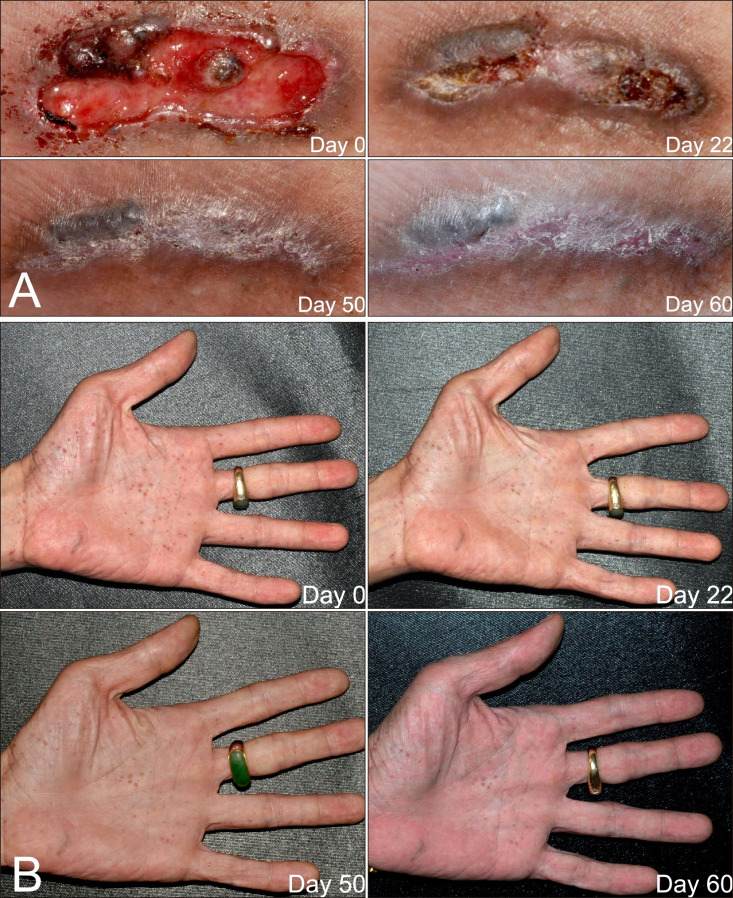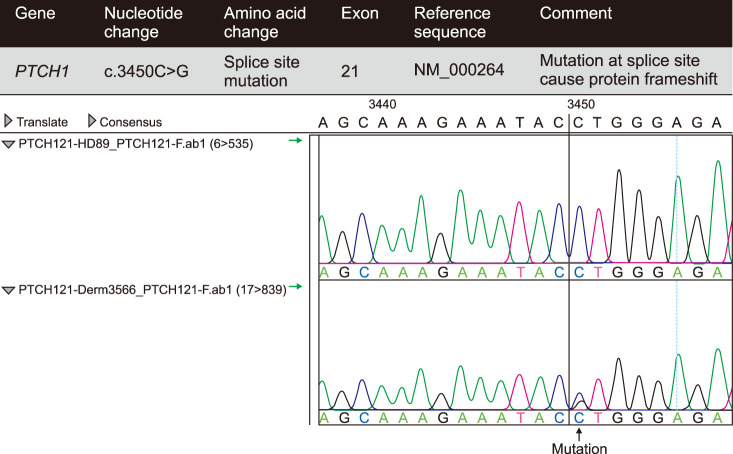Ann Dermatol.
2018 Oct;30(5):597-601. 10.5021/ad.2018.30.5.597.
Novel Patched 1 Mutations in Patients with Gorlin-Goltz Syndrome Strategic Treated by Smoothened Inhibitor
- Affiliations
-
- 1Department of Dermatology, Chang Gung Memorial Hospital, Linkou Branch, Taiwan. mr8095@cloud.cgmh.org.tw
- 2Chang Gung University College of Medicine, Taoyuan, Taiwan.
- 3Department of Dermatology, Drug Hypersensitivity Clinical and Research Center, Chang Gung Memorial Hospital, Linkou and Keelung, Taipei, Taiwan.
- 4Whole-Genome Research Core Laboratory of Human Diseases, Chang Gung Memorial Hospital, Keelung, Taiwan.
- KMID: 2419752
- DOI: http://doi.org/10.5021/ad.2018.30.5.597
Abstract
- We studied a family with Gorlin-Goltz syndrome. The novel mutations of our cases were located on the 21st exon of the PTCH1 gene (c.3450C>G). The father, who received a strategic 56-day vismodegib treatment for disease control, was the first patient with Gorlin syndrome treated with the hedgehog inhibitor in Taiwan. The lesions regressed gradually, with scar formation, and were subsequently removed via a wide excision. Further details are provided below.
Keyword
Figure
Reference
-
1. Gorlin RJ, Goltz RW. Multiple nevoid basal-cell epithelioma, jaw cysts and bifid rib. A syndrome. N Engl J Med. 1960; 262:908–912. PMID: 13851319.2. Farndon PA, Del Mastro RG, Evans DG, Kilpatrick MW. Location of gene for Gorlin syndrome. Lancet. 1992; 339:581–582. PMID: 1347096.
Article3. Hahn H, Wicking C, Zaphiropoulos PG, Gailani MR, Shanley S, Chidambaram A, et al. Mutations of the human homolog of drosophila patched in the nevoid basal cell carcinoma syndrome. Cell. 1996; 85:841–851. PMID: 8681379.
Article4. Smyth I, Narang MA, Evans T, Heimann C, Nakamura Y, Chenevix-Trench G, et al. Isolation and characterization of human patched 2 (PTCH2), a putative tumour suppressor gene inbasal cell carcinoma and medulloblastoma on chromosome 1p32. Hum Mol Genet. 1999; 8:291–297. PMID: 9931336.
Article5. Pastorino L, Ghiorzo P, Nasti S, Battistuzzi L, Cusano R, Marzocchi C, et al. Identification of a SUFU germline mutation in a family with Gorlin syndrome. Am J Med Genet A. 2009; 149A:1539–1543. PMID: 19533801.6. Jacobsen AA, Aldahan AS, Hughes OB, Shah VV, Strasswimmer J. Hedgehog pathway inhibitor therapy for locally advanced and metastatic basal cell carcinoma: a systematic review and pooled analysis of interventional studies. JAMA Dermatol. 2016; 152:816–824. PMID: 27096888.7. Boutet N, Bignon YJ, Drouin-Garraud V, Sarda P, Longy M, Lacombe D, et al. Spectrum of PTCH1 mutations in French patients with Gorlin syndrome. J Invest Dermatol. 2003; 121:478–481. PMID: 12925203.
Article8. Smith MJ, Beetz C, Williams SG, Bhaskar SS, O'sullivan J, Anderson B, et al. Germline mutations in SUFU cause Gorlin syndrome-associated childhood medulloblastoma and redefine the risk associated with PTCH1 mutations. J Clin Oncol. 2014; 32:4155–4161. PMID: 25403219.
Article9. Jayaraman SS, Rayhan DJ, Hazany S, Kolodney MS. Mutational landscape of basal cell carcinomas by whole-exome sequencing. J Invest Dermatol. 2014; 134:213–220. PMID: 23774526.
Article10. Tang JY, Mackay-Wiggan JM, Aszterbaum M, Yauch RL, Lindgren J, Chang K, et al. Inhibiting the hedgehog pathway in patients with the basal-cell nevus syndrome. N Engl J Med. 2012; 366:2180–2188. PMID: 22670904.
Article11. Yang X, Dinehart SM. Intermittent vismodegib therapy in basal cell nevus syndrome. JAMA Dermatol. 2016; 152:223–224. PMID: 26509945.
Article12. Dréno B, Kunstfeld R, Hauschild A, Fosko S, Zloty D, Labeille B, et al. Two intermittent vismodegib dosing regimens in patients with multiple basal-cell carcinomas (MIKIE): a randomised, regimen-controlled, double-blind, phase 2 trial. Lancet Oncol. 2017; 18:404–412. PMID: 28188086.
Article13. Jacobsen AA, Aldahan AS, Hughes OB, Shah VV, Strasswimmer J. Hedgehog pathway inhibitor therapy for locally advanced and metastatic basal cell carcinoma: a systematic review and pooled analysis of interventional studies. JAMA Dermatol. 2016; 152:816–824. PMID: 27096888.
- Full Text Links
- Actions
-
Cited
- CITED
-
- Close
- Share
- Similar articles
-
- The First Korean Case of Gorlin?Goltz Syndrome Caused by a PTCH2 Pathogenic Variant Identified via Whole Exome Sequencing
- Radiological features of familial Gorlin-Goltz syndrome
- Imaging findings in a case of Gorlin-Goltz syndrome: a survey using advanced modalities
- Multidisciplinary approach to Gorlin-Goltz syndrome: from diagnosis to surgical treatment of jawbones
- Basal cell nevus syndrome with excessive basal cell carcinomas




